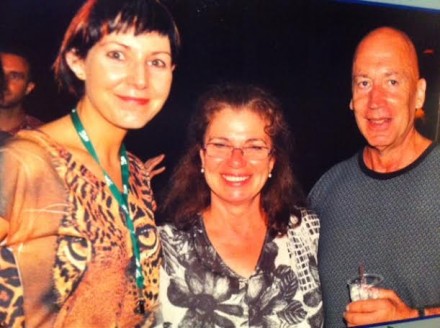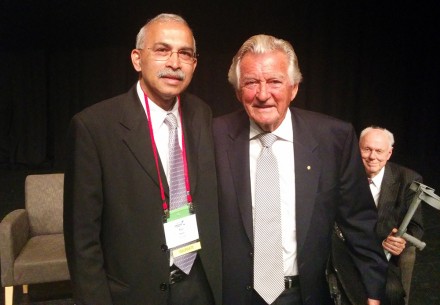Thank you to Jackie Randles for the update.
Neural Knitworks, the collaborative project about mind and brain health, was first on show last August at the Hazelhurst Regional Gallery during National Science Week. A giant, walk in brain sculpture made from more than 1600 knitted, crocheted and woven brain cells donated from all over Australia was created by textile artists Pat Pillai and Rita Pearce.
Many other neuron-inspired artworks from delicate crotched neurons to jewellery and sculpture accompanied the impressive brain installation that was the centerpiece of this exhibition seem by thousands of visitors over a three-week period.
So far Neural Knitworks has seen dozens of knit-ins held across the country at which people of all ages and abilities get together to create textile neurons and find out about neuroscience at the same time from guest presenters. The project’s aim is to encourage community members to learn about neuroscience as they have some fun with yarn craft and reap the benefits that it can bring – in particular mindfulness, creativity, learning something new and being with others. Take up of this grass roots initiative has been sensational, with more than 12000 people visiting the Neural Knitworks webpage in the project’s first 6 months.
In 2015 Neural Knitworks continues and all are encouraged to get involved!
This year we’re encouraging people everywhere to create a brain installation in their own community. We need as much help as we can get to spread the word and inspire people to have a go. Scientifically informed patterns and installation ideas are available on the National Science Week website so that everyone can enjoy the experience of yarn craft in a group.
It’s a great way for people of all ages to learn about the billions of neurons in our bodies that save memories, send electrical signals to every muscle and receive signals from every sense. The best thing about this community art/science project is that everyone can get hands on with knitting neurons no matter their age or level of competence.
Rita and Pat have enjoyed running yarn craft sessions with Dementia sufferers and we’ve had wonderful neurons donated from knit ins held at kindergardens, age care facilities, universities and schools. No knit patterns are especially popular with those of us who cannot yet knit or crotchet and participants have ways to make other brain cell like astrocytes. A group has even begun making footy neurons to raise awareness of brain injury in sport.
Not surprisingly, the project has been popular with neuroscientists, attracting support from luminaries like Professor Ian Hickie, Director of the Brain and Mind Research Institute and brain surgeon Dr Charlie Teo, who each led knit ins that were covered by the media last year. Pat and Rita have been invited to present at international brain imaging conferences and will be heading to Brisbane later this year to lead a knit in at QUT with Queensland based neuroscientists.
We anticipate that many more brain experts will again join knit ins this year and to promote important brain health messages in the community. There are many angles that can be explored, from adolescent brains and ageing through to addiction, dementia, brain injury, depression and more. Why not get a group together and invite a brain expert to join you at a knit in? We need your help to keep this national neural network thriving and look forward to seeing your creations on Facebook where you can join us here. https://www.facebook.com/groups/648068261927343/
Congratulations to artists Pat Pillai and Rita Pearce who have been so successful in bringing community members together with leading neuroscientists and brain health experts. What a fantastic and inspiring science communication success story!
Jackie Randles is Manager, Inspiring Australia (NSW). Neural Knitworks is supported by the Brain and Mind Research Institute, Alzheimer’s Australia, ANSTO, Inspiring Australia (NSW), National Science Week, the Centre for Healthy Brain Ageing, Hazelhurst Regional Gallery and Arts Centre, Gymea Tradies, Your Brain Health and Carringbah Lions Club. Find out more on the National Science Week website at www.scienceweek.net.au/neuralknitworks


